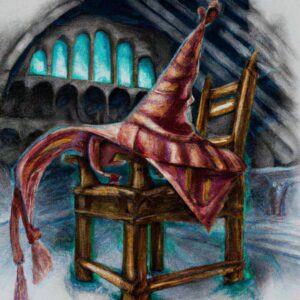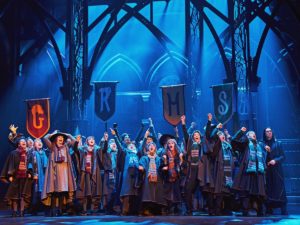If Hogwarts Houses were The Four Elements
Introduction to Hogwarts Houses and The Four Elements
If Hogwarts Houses were The Four Elements, one might find a deeply symbolic and enchanting connection. At Hogwarts School of Witchcraft and Wizardry, the four houses—Gryffindor, Slytherin, Ravenclaw, and Hufflepuff—each carry distinct traits that set them apart. As magical as they are, these houses can be intriguingly associated with the ancient concept of the four classical elements: Fire, Water, Air, and Earth. This correlation not only adds depth to the understanding of each house but also enriches our appreciation of the diverse characters within the Harry Potter series.
Gryffindor, known for its courage and bravery, aligns seamlessly with the element of Fire. Slytherin, with its ambition and cunning, embodies the fluidity and adaptability of Water. Ravenclaw values intellect and creativity, qualities mirrored by the element of Air. Lastly, Hufflepuff is synonymous with loyalty and hard work, grounded characteristics that resonate with the element of Earth.
Understanding these elemental connections offers significant insight into the character traits that define the houses. It allows us to explore how these elements influence the personalities and actions of prominent figures in the wizarding world. Let’s delve deeper into each house and its elemental counterpart, exploring how these traits are both reflected and enhanced through the magical lens of the four elements.
Gryffindor and the Element of Fire
At the core of Gryffindor House lie courage, bravery, and a daring nature—traits that burn as fiercely as the element of Fire. These qualities define Gryffindor students, who are often willing to take risks and face challenges head-on. The element of Fire symbolizes vitality, passion, and transformation, which are deeply embedded within the Gryffindor spirit.
Fire holds a special place in magical traditions, often representing purification and renewal. Its association with Gryffindor is evident in the bold actions and fiery tempers of its members. Harry Potter himself exemplifies Gryffindor’s fiery spirit through his relentless bravery and determination to confront evil. From battling dragons to facing Voldemort, Harry’s actions are propelled by a burning desire to protect and bring about change.
Gryffindor embodies passion and transformation, qualities that are inherently fiery. This house fosters an environment where students are encouraged to pursue their goals with enthusiasm and vigor. Famous Gryffindors like Hermione Granger and Ron Weasley also reflect these fiery qualities. Hermione’s fierce intellect and Ron’s unwavering loyalty demonstrate how Gryffindors transform challenges into opportunities for growth.
Whether it’s the chivalrous Godric Gryffindor himself or modern heroes like Neville Longbottom, Gryffindors are known for their courage and willingness to stand up for what is right. Their fiery nature fuels their drive, pushing them to rise above adversity and inspire others to do the same.
Slytherin and the Element of Water
Slytherin House is characterized by ambition, cunning, and resourcefulness—traits that mirror the fluid and adaptable nature of Water. Known for their strategic thinking and desire to succeed, Slytherins adeptly align with the element of Water, which symbolizes intuition, emotion, and adaptability.
Water’s significance in magical contexts often highlights its transformative and healing properties. In the wizarding world, water is a symbol of rebirth and reflection, making it a fitting match for Slytherin’s ability to adapt and devise innovative solutions. Severus Snape, a quintessential Slytherin, exemplifies these water-like qualities through his complex and multifaceted nature. His ability to navigate between different roles, while maintaining his core ambitions, showcases the fluidity of Slytherin’s traits.
Slytherin’s connection to intuition and adaptability is further evident in their strategic thinking and ability to achieve their goals through unconventional means. Slytherins, like Draco Malfoy, often demonstrate a keen sense of self-preservation and an ability to read situations, aligning with water’s reflective and introspective characteristics.
Notable Slytherins such as Merlin and Horace Slughorn also exhibit water-like qualities. Their resourcefulness and ambition, paired with a deep understanding of their environment, allow them to make impactful decisions. This water element endows Slytherins with the ability to adapt and thrive, regardless of the challenges they face.
Ravenclaw and the Element of Air
The house of Ravenclaw is defined by intellect, wisdom, and creativity, all of which are airy attributes that align seamlessly with the element of Air. Valuing knowledge and the pursuit of understanding, Ravenclaws are akin to Air—symbolizing clarity, freedom, and inspiration.
Air, in magical symbolism, represents communication, intellect, and the power of thought. This element pairs beautifully with Ravenclaw’s emphasis on intelligence and creativity. Luna Lovegood, a standout Ravenclaw, epitomizes these airy qualities through her imaginative perspective and open-mindedness. Her unique way of seeing the world embodies the clarity and boundless nature of Air.
The importance of clarity and thoughtfulness in Ravenclaw is apparent in their pursuit of wisdom and understanding. Ravenclaw’s airy traits foster an environment where students are encouraged to explore ideas, solve problems, and think critically. This house nurtures innovation and intellectual growth, allowing students to soar beyond conventional boundaries.
Distinguished Ravenclaws such as Rowena Ravenclaw and Filius Flitwick demonstrate air qualities through their contributions to magical knowledge and education. Their legacy of wisdom continues to inspire Ravenclaws to seek truth and embrace the power of intellectual freedom.
Hufflepuff and the Element of Earth
Hufflepuff House is renowned for hard work, patience, and loyalty—earthy features that resonate deeply with the element of Earth. Known for their dedication and nurturing nature, Hufflepuffs embody the steadfast and grounding qualities of Earth, which symbolizes stability, growth, and nurturing.
Earth’s symbolism in magical contexts often highlights fertility, endurance, and the cycle of life, aligning perfectly with Hufflepuff’s emphasis on hard work and loyalty. Newt Scamander, a notable Hufflepuff, exemplifies these earth characteristics through his grounded and compassionate approach to magical creatures. His dedication to understanding and protecting creatures reflects the nurturing aspect of Hufflepuff.
Hufflepuff’s connection to stability and nurturing is further evident in their commitment to fairness and community. Hufflepuffs like Cedric Diggory showcase the importance of working together and supporting others, embodying the enduring and supportive nature of the Earth element.
Prominent Hufflepuffs such as Helga Hufflepuff and Nymphadora Tonks personify earth characteristics through their unwavering loyalty and willingness to stand by their friends. The element of Earth empowers Hufflepuffs to build lasting bonds and provide a solid foundation for those around them.
















